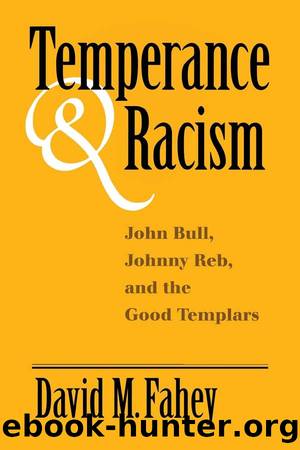Temperance And Racism by David M. Fahey

Author:David M. Fahey [Fahey, David M.]
Language: eng
Format: epub
Tags: History, General, Social Science, Ethnic Studies, American, African American & Black Studies, Modern, 19th Century, Philanthropy & Charity
ISBN: 9780813185576
Google: 60YoEAAAQBAJ
Publisher: University Press of Kentucky
Published: 2021-10-21T22:13:16+00:00
5
The Black Templars
In contrast to the abundance of information on how white Templars viewed black Templar membership, there is only skimpy evidence about the black Templars themselves and even less about how other blacks regarded the IOGT. Historians of African American organizational life almost never mention the Good Templars, and biographers of blacks who held high Templar office seldom explore this phase of their lives. The general neglect of African American fraternal societies and the black temperance movement helps explain this oversight. Moreover, much of the source material for the black Templars lies buried in British temperance newspapers, not the place where research on African American history is commonly conducted.
In recruiting black members the Templar factions were helped by prevailing African American ideologies and social organization. In the nineteenth century blacks often made the analogy between drink and slavery, temperance and freedom.1 A tradition of temperance reform among the black community in the northern states dated from preâCivil War times. Maineâs Abyssinian Total Abstinence Society claimed 176 members in the early 1840s. The temperance movement spread to the former slave states after the abolition of slavery. In 1867, for instance, Missouriâs Colored Temperance Society held a fund-raising Independence Day picnic near Columbia. Although there were exceptions, the black men and women who joined the IOGT did so for the most part as teetotalers or moderate drinkers, not as alcoholics seeking to save themselves from a drinking problem. A Templar in Tallahassee declared himself âa Temperance young man before I joined the Orderâ but added âI am stronger since I joined it.â2
In the absence of well-developed African American temperance societies, the churches dominated the black temperance movement. Methodist conferences often called for restraint in drinking alcohol. A black Templar, not himself a Methodist, credited âchiefly . . . ministers of the A.M.E. Churchâ for the growth of the IOGT among African Americans. He added praise for a presiding elder of the A.M.E. Zion Church, the other major black Methodist denomination.3
A.M.E. clergy and laity joined the RWGL of the World in disproportionate numbers. Admittedly, some of these Templar memberships were nominal like that of the celebrated Bishop Daniel A. Payne, but other Methodists joined the IOGT to work.4 A future A.M.E. bishop was the first GWCT for the Malinites in Virginia. The Grand Lodge of South Carolina gained momentum when all the ministers at an A.M.E. conference joined a special lodge; at least three chiefs of this Grand Lodge were A.M.E. ministers. The A.M.E. weekly newspaper, the Christian Recorder, became the Malinite organ in the United States. It published a section of Templar news under the RWGL of the World seal, which displayed a black man and a white man shaking hands. Malins himself, in the United States for a meeting of the RWGL of the World in 1878, organized Fraternity lodge at the Philadelphia headquarters of the Christian Recorder, with its staff as the membership.5 At a Templar meeting in Ireland the newspaperâs editor, Dr. B.T. Tanner, rejoiced that âGood Templary brought all upon one platform.
Download
This site does not store any files on its server. We only index and link to content provided by other sites. Please contact the content providers to delete copyright contents if any and email us, we'll remove relevant links or contents immediately.
Cecilia; Or, Memoirs of an Heiress — Volume 1 by Fanny Burney(32440)
Cecilia; Or, Memoirs of an Heiress — Volume 2 by Fanny Burney(31875)
Cecilia; Or, Memoirs of an Heiress — Volume 3 by Fanny Burney(31858)
The Great Music City by Andrea Baker(31531)
We're Going to Need More Wine by Gabrielle Union(18973)
All the Missing Girls by Megan Miranda(15595)
Pimp by Iceberg Slim(14399)
Bombshells: Glamour Girls of a Lifetime by Sullivan Steve(13979)
Talking to Strangers by Malcolm Gladwell(13233)
Norse Mythology by Gaiman Neil(13215)
Fifty Shades Freed by E L James(13163)
For the Love of Europe by Rick Steves(13106)
Mindhunter: Inside the FBI's Elite Serial Crime Unit by John E. Douglas & Mark Olshaker(9209)
Crazy Rich Asians by Kevin Kwan(9173)
The Lost Art of Listening by Michael P. Nichols(7412)
Enlightenment Now: The Case for Reason, Science, Humanism, and Progress by Steven Pinker(7242)
The Four Agreements by Don Miguel Ruiz(6640)
Bad Blood by John Carreyrou(6558)
Weapons of Math Destruction by Cathy O'Neil(6152)
